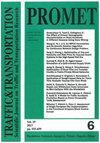收入管理系统推行辅助服务的检讨
IF 1.1
4区 工程技术
Q4 TRANSPORTATION SCIENCE & TECHNOLOGY
引用次数: 0
摘要
航空运输的辅助服务是指提供给旅客选择的一系列服务,使旅客在提升旅行体验的同时,为航空公司积累额外的收入。低成本航空公司率先采取了这种做法,但在过去十年中,辅助服务与基本服务的分离已成为航空运输业日益增长的趋势。这种做法使廉价航空公司大大降低了基本服务的价格。为了在搜索引擎提供的透明时代保持竞争力,传统航空公司在基本服务之外还提供辅助服务。为了满足乘客的需求,我们推出了一系列的辅助服务。但是,现有的收入管理系统在计算保留限额时没有考虑到这种辅助收入。如果航空公司知道某位乘客愿意为辅助服务支付更多费用,该系统将能够在预订过程中为该乘客调整服务的可用性。本文回顾了乘客对辅助服务的支付意愿的研究,以及对辅助服务个性化的研究和将个性化定价纳入现有收入管理系统的挑战的综述。本文章由计算机程序翻译,如有差异,请以英文原文为准。
A Review of Ancillary Services Implementation in the Revenue Management Systems
Ancillary services in air transport represent a set of services provided to passengers to choose from, enabling them to enhance their travel experience while accumu-lating additional airline revenue. Low-cost airlines pi-oneered the practice, but the separation of ancillary services from the basic service has become an intense-ly growing trend in the air transport industry over the last decade. This practice has enabled low-cost airlines to significantly reduce the price of the basic service. To remain competitive in an era of transparency provided by search engines, traditional airlines offer ancillary ser-vices in addition to the basic service. To meet the passen-ger’s needs, a whole range of ancillary services has been created. However, existing revenue management systems do not take this ancillary revenue into account when cal-culating reservation limits. If the airline knew that an in-dividual passenger is willing to pay more for ancillary services, the system would be able to adjust the availabil-ity of the service for that passenger during the booking process. A review of research on passengers’ willingness to pay for ancillary services is presented in the paper, as well as a review on research on the personalisation of ancillary services and challenges of integrating person-alised pricing into existing revenue management systems.
求助全文
通过发布文献求助,成功后即可免费获取论文全文。
去求助
来源期刊

Promet-Traffic & Transportation
工程技术-运输科技
CiteScore
1.90
自引率
20.00%
发文量
62
审稿时长
3 months
期刊介绍:
This scientific journal publishes scientific papers in the area of technical sciences, field of transport and traffic technology.
The basic guidelines of the journal, which support the mission - promotion of transport science, are: relevancy of published papers and reviewer competency, established identity in the print and publishing profile, as well as other formal and informal details. The journal organisation consists of the Editorial Board, Editors, Reviewer Selection Committee and the Scientific Advisory Committee.
The received papers are subject to peer review in accordance with the recommendations for international scientific journals.
The papers published in the journal are placed in sections which explain their focus in more detail. The sections are: transportation economy, information and communication technology, intelligent transport systems, human-transport interaction, intermodal transport, education in traffic and transport, traffic planning, traffic and environment (ecology), traffic on motorways, traffic in the cities, transport and sustainable development, traffic and space, traffic infrastructure, traffic policy, transport engineering, transport law, safety and security in traffic, transport logistics, transport technology, transport telematics, internal transport, traffic management, science in traffic and transport, traffic engineering, transport in emergency situations, swarm intelligence in transportation engineering.
The Journal also publishes information not subject to review, and classified under the following headings: book and other reviews, symposia, conferences and exhibitions, scientific cooperation, anniversaries, portraits, bibliographies, publisher information, news, etc.
 求助内容:
求助内容: 应助结果提醒方式:
应助结果提醒方式:


